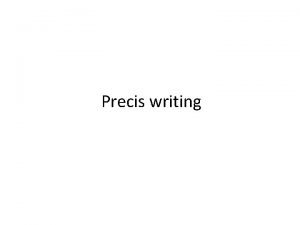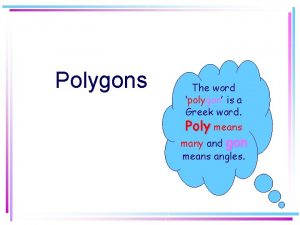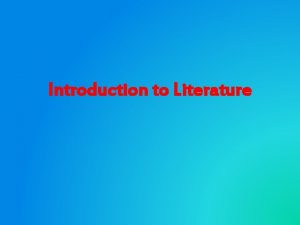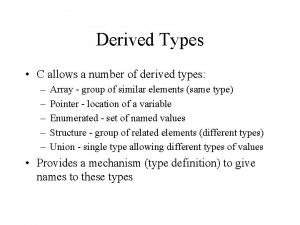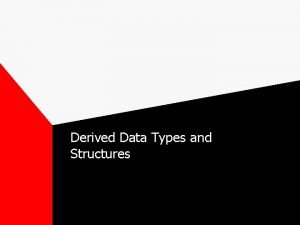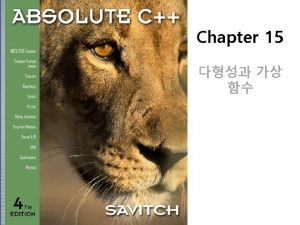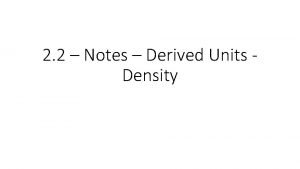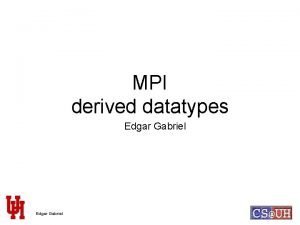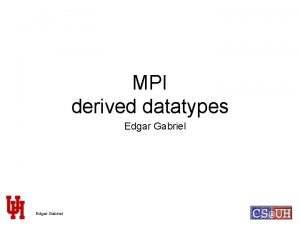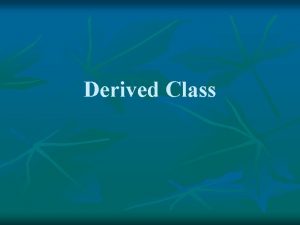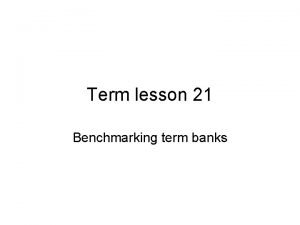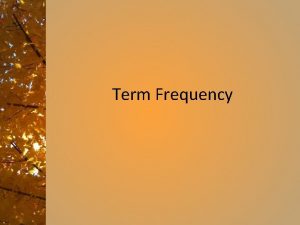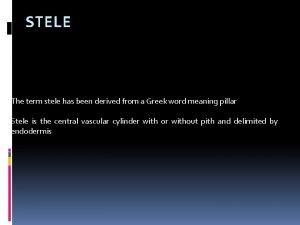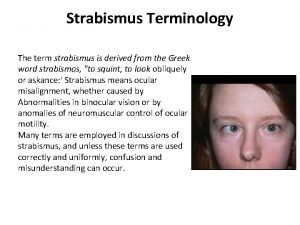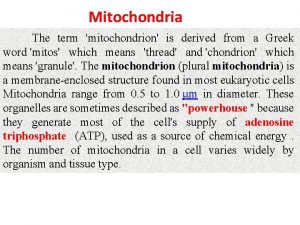LECTURE The term lecture was derived from the







































- Slides: 39


LECTURE

The term lecture was derived from the Greeks , Latin lectare, means to read aloud (fifth century BC). In medieval times lecture were the most common form of teaching in both Christian and Muslim universities

Lectures are, potentially, an economical and efficient method of conveying information to large groups of students.

Learning from lecture (explanatory model ) Student receives Lecturer transmits Attention perception Lecturer´s Intention Verbal Extra-verbal Non-verbal Audio-verbal aids ( Short term memory Student reacts Long Term Memory OUTPUT: Notes Reactions

Lecturing Model • • Intention Transmission Receipt of information Output

AT IO TIV E MO G RA VE CO N Intention UNDERSTANDING

Transmission • VERBAL § objectives, definitions, descriptions of signs and symptoms, examples, exceptions, explanations or comments. • EXTRA VERBAL § vocal qualities, hesitations, stumbles, speech errors and use of pauses and silence. • NON VERBAL § Eye contact, gestures and body movements. • AUDIO-VISUAL AIDS § chalkboards, transparencies, slides

Receipt of information What they perceive is determined in part by: • • • what they already know? what they are interested in? Levels of attention and arousal of student.

Attention fluctuates throughout a one-hour lecture performance A peak a tten just befo tion re t lecture e he nds 20 10 20 Lecture period in minute

Message stored in shortterm memory till 30 sec Subject The long-term memory receives messages that are closely related to the network of concepts and facts which stored in it and have been activated.

Tricycle anti depressant Gabapentin Side effect Subject Drug intraction between gabapentin & tricyclic anti depressant Diabetic neuropathy Message stored in shortterm memory till 30 sec The long-term memory receives messages that are closely related to the network of concepts and facts which stored in it and have been activated.

The episodic (narrative) component of longterm memory stores ‘stories’ that are easier to retrieve than information stored in the conceptual (semantic) memory

Output • • A student’s response or ‘output’ is not only a set of notes that may be understood and, if necessary, restructured and learnt; it also consists of reactions to the lecture and the lecturer More important than the immediately observable responses to a lecture are the long-term changes in attitudes and understanding which may occur in a student.

ERROR DIAGNOS A simple but powerful test of the gap between intention and receipt is to compare the key points in your notebook with the notes of your student

The skill of lecturing

The skill of lecturing • • • Explaining Improving clarity Generating interest

Explaining • Explaining is giving understanding to another. Understanding is the creation of new connection in the minds of the learner. These connection may be between facts and ideas.

Explaining • • • Interpretative Descriptive Reason-giving

Improving clarity Clear explanations are, as indicated, dependent upon knowing precisely what one wishes to explain to whom, transmitting the explanation and checking, when possible, whether the explanation has been understood.

Improving clarity Four ways of improving clarity: § § Minimize vagueness, Provide a clear structure. Sharpen the focus, Use structuring moves

Improving clarity • • Signposts Frame Foci Links

Generating interest • First § Eye contact, gesture, body movement, facial expression, vocal inflection and choice of vocabulary. • Second § Apt examples and analogies • Third § Appropriate mode of explaining

Appropriate mode of explaining • • • Narrative § In the narrative mode the lecturer explains an event or a set of research findings in the form of a personal story Anecdotal § In the anecdotal mode the lecturer uses humorous stories or moral fables to illustrate the key points. Conceptual § In the conceptual mode, the lecturer provides a series of principles or facts in a logical order

Preparing lecture • • • Step 1: What is the topics? Step 2: Free associate Step 3: State a working title Step 4: Analyse the “hidden” variables in the title Step 5: Preparee a rough structure of the lecture Step 6: Directed reading Step 7: structure the lecture Step 8: Check the opening and ending Step 9: Give the lecture Step 10: Reflect and note

• • • Introduction Body/Discussion Conclusion

• The Introduction § § § Gain attention Establish relevance Provide overview Establish ground rules Identify goals

Body • • Begin by restating each main point/learning goal Explain and demonstrate main points § • Present essential points first, followed by most important next, and “nice to know” last Use examples to facilitate understanding § § At least one example per idea Use several examples for complex ideas

• Have students practice using main points § provide problems, cases, questions, etc. , • • Briefly summarize at end of each main point Provide transition statement to next main point

Conclusion • • Provides a logical ending – a sense of completeness and structure. Restate main points (“Summary”) Restate purpose sentence and how topic relates to audience (“Objectives" & "Motivation”) Connect with other instructional segments of past and future (“Integration”)

• • Check to see whether students have accomplished the main purpose of the lecture Finish with a flourish § on time § Enthusiastic § use an attention getter

Method in structuring lectures? • • The classical The problem center The sequential The comparative

Handout • Outlines • Interactive handouts • Key information handouts • Full handouts • Tasks and problems handouts § Provide a one-page summary of the lecture and some annotated key references § contain skeletal notes and diagrams that the students have to complete during the lecture § provide complex diagrams, references, quotations, formula, proofs § Virtually a transcript of the lecture § The tasks or problems that are to be used in the lecture so

Interactive lecturing

Attention span break 15 Minute 5 minute Pace lectures in 15 -20 minute segment. Instructors needs to change their pace at regular intervals 5 minute •

Buzz Group A simple and effective method of involving students

• Reflecting on and improving note-taking (Ask students to compare their notes with two other people in class) • Checking student understanding (Ask student to respond to one or two question)

Evaluating lectures • • • Student learning & reaction Peer feedback Reflective practice (self evaluation)

THANK YOU !
 Lecture is derived from
Lecture is derived from Precis is connected with the french word
Precis is connected with the french word (5-2)x180
(5-2)x180 The term audit is originated from a latin word
The term audit is originated from a latin word Photography comes from the greek words photos
Photography comes from the greek words photos Latin word of literature
Latin word of literature 01:640:244 lecture notes - lecture 15: plat, idah, farad
01:640:244 lecture notes - lecture 15: plat, idah, farad Short term financial management
Short term financial management Short term human resource planning
Short term human resource planning Nth term rule
Nth term rule In my understanding
In my understanding Term to term rule
Term to term rule Term to term rule
Term to term rule Long term memory vs short term memory
Long term memory vs short term memory Difference between long term and short term liabilities
Difference between long term and short term liabilities Short-term and long-term goals examples
Short-term and long-term goals examples Quadratic sequences
Quadratic sequences Minterm maxterm
Minterm maxterm Long term liabilities
Long term liabilities Long medium and short term planning in primary schools
Long medium and short term planning in primary schools Sự nuôi và dạy con của hươu
Sự nuôi và dạy con của hươu Từ ngữ thể hiện lòng nhân hậu
Từ ngữ thể hiện lòng nhân hậu Diễn thế sinh thái là
Diễn thế sinh thái là Vẽ hình chiếu vuông góc của vật thể sau
Vẽ hình chiếu vuông góc của vật thể sau 101012 bằng
101012 bằng Tỉ lệ cơ thể trẻ em
Tỉ lệ cơ thể trẻ em Lời thề hippocrates
Lời thề hippocrates Vẽ hình chiếu đứng bằng cạnh của vật thể
Vẽ hình chiếu đứng bằng cạnh của vật thể đại từ thay thế
đại từ thay thế Quá trình desamine hóa có thể tạo ra
Quá trình desamine hóa có thể tạo ra Các môn thể thao bắt đầu bằng tiếng đua
Các môn thể thao bắt đầu bằng tiếng đua Công thức tính độ biến thiên đông lượng
Công thức tính độ biến thiên đông lượng Hát kết hợp bộ gõ cơ thể
Hát kết hợp bộ gõ cơ thể Sự nuôi và dạy con của hươu
Sự nuôi và dạy con của hươu Thế nào là mạng điện lắp đặt kiểu nổi
Thế nào là mạng điện lắp đặt kiểu nổi Dot
Dot Thế nào là sự mỏi cơ
Thế nào là sự mỏi cơ độ dài liên kết
độ dài liên kết Chó sói
Chó sói Thiếu nhi thế giới liên hoan
Thiếu nhi thế giới liên hoan

